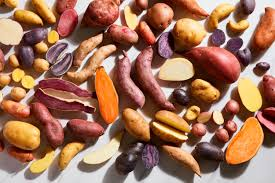Despite its seeming simplicity, the potato has an interesting history of variety and adaptation. This adaptable tuber was first cultivated in the Andes highlands thousands of years ago and has since spread around the world to become a staple in nearly every cuisine. The fact that there are thousands of potato types, each adapted to a distinct environment, cooking method, and cultural custom, is what makes potatoes so popular worldwide, in addition to their availability and affordability. Unique potato varieties are served in various ways that represent local cuisines and traditions, from Peru to India and Ireland to Japan.
The Origin Of Diversity In South America
The world’s largest variety of potato types is found in South America, especially in Bolivia and Peru. More than 4,000 varieties, ranging in hue from brilliant yellow to deep purple, have been grown by Andean farmers. In traditional meals, each variation has a distinct function.
Chuño, for instance, is a centuries-old preservation method that is still in use today and is prepared by freeze-drying potatoes at high elevations. These preserved potatoes serve as the foundation for stews and soups, providing sustenance throughout the severe Andean winters. Other types, like the papa amarilla with yellow flesh, are valued for their creamy texture and are necessary for recipes like causa, which is a layered salad of potatoes with shellfish.
In this context, potatoes represent more than just food; they are associated with spiritual and cultural identity, and they are often honored as resilient and life-giving symbols during festivals.
Ireland: A History Of Fortitude
The potato’s excellent nutritional content and capacity to thrive on unfavorable soils made it a staple crop in Ireland in the 18th century. The potato continued to play a major role in Irish cuisine even though the Great Famine of the 1840s highlighted the dangers of depending too much on a single crop.
Starchy types like Russets are usually preferred by Irish chefs since they are excellent for mashing and boiling. The flexibility of this foodstuff is shown by traditional recipes like boxty (potato pancakes) and colcannon (mashed potatoes with cabbage). In Ireland, potatoes are more than simply a side dish; they are a representation of comfort, tenacity, and survival.
India: A Blend Of Spice And Potato
The potato swiftly blended in with India’s many and diverse cuisines after arriving there during the colonial era. It is now one of the most popular veggies in the country. Indian cuisine demonstrates how different types of potatoes can both absorb and enhance strong spices.
The tuber has become an essential part of Indian cuisine, from samosas filled with spicy potato stuffing to aloo gobi, a mixture of potatoes and cauliflower with turmeric and cumin. During floury potatoes are mashed into fillings or served with flatbreads like paratha, waxy potatoes, which maintain their form during cooking, are popular for curries and stir-fries.
A Land Of Many Potatoes: The United States
The United States has embraced potatoes in many different ways, from creamy Yukon Golds to roasted Russets. States also specialize in different types of potatoes—Idaho is known for its starchy Russets, while Wisconsin is known for its red potatoes.
The potato has evolved into a symbol of adaptability in American society. Every kind of potato contributes to the creation of regional favorites, whether they are roasted with herbs, mashed with gravy, or served as French fries. For example, bigger Russet potatoes are still the preferred choice for traditional baked potatoes, while fingerling potatoes are popular at farm-to-table restaurants due to their gourmet appeal.
Africa: Adapting To Potatoes
During the 20th century, potatoes expanded worldwide despite not being native to Africa. They are now cultivated in South Africa, Ethiopia, and Kenya’s highlands. Hardy potato types that can tolerate a variety of conditions and produce consistently are often preferred by farmers.
Uses in cooking are just as diverse. In Kenya, potatoes are often cooked or fried with spices and tomatoes. They are often used in hearty stews and curries in South Africa. Because of their adaptability to various culinary techniques, potatoes have become essential elements in local cuisines.
Conclusion
Although potatoes are a common ingredient in many cuisines, each culture’s treatment of them is distinct. From the rainbow-colored tubers of the Andes to the subtle scents of Japanese nimono and the fiery depth of Indian curries, potato varieties demonstrate how one simple crop can be transformed in a multitude of ways.
Potatoes serve as more than simply food; they are a link between geography, history, and custom. They are anchored in the earth, but their cultural importance is embedded in the hearts and minds of people worldwide, as their global voyage demonstrates.

